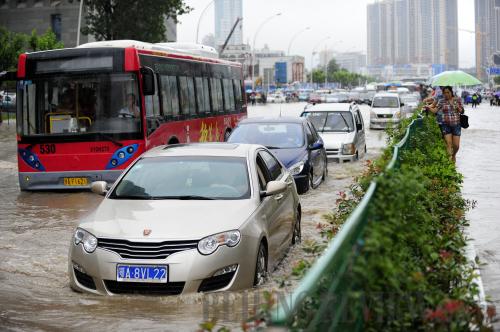Last year, two thirds of the 374.5 billion yuan ($54.83 billion) in damages caused by floods in China was incurred by cities, according to figures from the Ministry of Water Resources.
"As the cities have grown, infrastructure like underground drainage networks have not kept up," said Li Yuhong, former chief engineer of the Urban Management Office for Rivers and Lakes under the Beijing Water Authority. All in all, more than 250 county-level cities found themselves suffering from an excess of water last year.
Recent downpours in Beijing and Wuhan share a common characteristic: heavy but unevenly distributed. Within an hour several streets in these cities were knee-deep in water.
According to the Beijing Municipal Flood Control and Drought Relief Headquarters, the city's drainage system was designed to cope with a maximum rainfall of 45 mm per hour. Only in some key areas does the drainage system have a comparatively higher capacity, for example the Tiananmen Square in city's heart. But the rain on June 23 reached 128 mm an hour, causing flooding up to 600 mm deep at 20 locations.
Beijing's drainage system is made up mainly of old facilities. Some key drains even date back to the Ming Dynasty (1368-1644). When rain is too heavy, administrators have to order the opening of drainage covers to allow floodwaters to subside faster.
Wang said in light of recent floods, authorities were considering upgrading the city's drainage infrastructure and doubling its capacity.
"The outdated drainage system exposes a problem in urban planning because underground construction is equally important to that above ground," said Yang Zhongguang, Deputy Director of the Research Center for Urban Development and Environment at the Chinese Academy of Social Sciences.
However, most cities in China have lavished the bulk of their construction budgets on areas of maximum visibility, while neglecting crucial but invisible infrastructure, such as drainage systems.
Media reports suggest more than 200 skyscrapers are under construction across China, more than the number of existing skyscrapers in the United States.
But the upshot of these image building projects is that a greater developed area means less rainfall is absorbed into the ground, and a larger volume of water has to be drained by a neglected drainage system.
In Wuhan, for instance, the total surface area of lakes and ponds has gone down by over 25 percent in the last 30 years, while the city's built-up area has more than doubled.
According to Zhou Yuwen, a professor at the Beijing University of Technology, drainage capacity standards in many Chinese cities are only set to prevent floods at the once-in-a-year level, and have not been further updated.
"Such a standard is obviously lower than what is needed, especially for major cities," Zhou said.
In May, torrential rains triggered flash floods and drenched Guangzhou, capital of southern Guangdong Province. Having suffered economic losses mounting to roughly 543.8 million yuan ($79.62 million) from the floods, the city government has vowed to revamp its 6,000-km-long downtown drainage network.
According to the Guangzhou Water Authority, 83 percent of municipal drainage pipes were built to handle flood surges at most once a year, and 9 percent were built to handle such surges twice a year.
In contrast, drainage systems in major cities of developed countries are far more sophisticated.
Ye Qing, a lawmaker at the National People's Congress from Wuhan, said when he visited the drainage system in Paris, France, he saw underground sewers wide enough to drive a car through.
"Paris' gutters, hidden 50 meters underground, are two meters deep and three meters wide, with one-meter-wide tunnels on the side for workers to do maintenance work," Ye said.
In Tokyo, Japan, the drainage system is designed to prevent rains at a once-in-10-year level, and its underground drainage river is 60 meters deep.
Recently, authorities released statistics on drainage systems in China's cities in 2010. Two cities were praised, one being Ganzhou in Jiangxi Province with sewers dating back more than 1,000 years and the other Qingdao in Shandong Province with sewers primarily built in the early 1900s.
Ironically, according to the report, sewers in old districts of these two cities were found to be particularly effective, while those constructed in newer districts tended to work less well.
"A sewer is a city's underground backbone. It's like building the foundation of a house. A city also needs foundational structures," said Professor Zhou. Perhaps city authorities in China can learn from old districts of these two cities and improve on modern building standards.


















